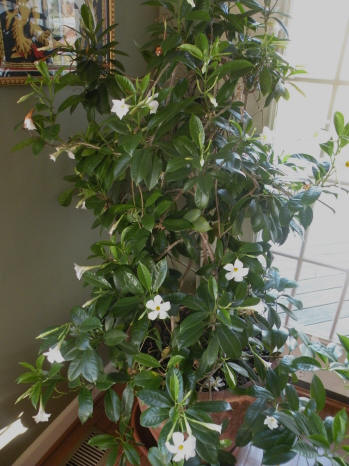Lisha Utt
Frederick County Master Gardener
 Annuals by definition are plants that grow, flower and produce seed in one growing season. But if you're not ready for this growing season to end, you can bring many of your favorite annuals indoors. Some of the annuals that do well inside
include impatiens, begonias, geraniums, coleus verbena and browallia. I've also had great luck with mandevilla vine.
Annuals by definition are plants that grow, flower and produce seed in one growing season. But if you're not ready for this growing season to end, you can bring many of your favorite annuals indoors. Some of the annuals that do well inside
include impatiens, begonias, geraniums, coleus verbena and browallia. I've also had great luck with mandevilla vine.
Annuals that have been growing in the ground can be carefully dug up and repotted. Some annuals including impatiens and coleus can also be easily rooted in water and then transferred to a pot.
Before bringing in the plants, many gardeners recommend cutting the annuals back to half their original height to make them fuller. I prefer to just prune away any wayward stems and remove all spent blooms and dead leaves. The pleasure for me is bringing the full blooming plant indoors and enjoying
it right away. If the plant does get leggy later in the winter I'll prune them back harder, preferably after the holidays.
It is also important to inspect your plants for pests before bringing them indoors. No use inviting in trouble if you can avoid it. I typically spray the annuals with insecticidal soap before taking them inside, following all the label directions.
All of the annuals will require as much light as possible, a south facing window is ideal. Be careful not to over water the plants. They will not require near the amount of water indoors as they did outdoors. Wait until the surface of the soil is dry between watering. I find watering once a week is
a good rule of thumb.
Do not be dismayed if some of the leaves and/or blooms turn brown and drop when you first bring in the plant. New growth will soon replace these as the plant gets used to its new indoor location.
Throughout the winter keep an eye out for pests. Two of the most common are spider mites and aphids. Spider mites are tiny, sap-sucking insects that infest the underside of a plant's leaves. The top of the leaves can have yellow splotches or graying color. When the infestation is heavy you may see
white webbing between the leaves and stems. Aphids are also small, sap-sucking insects, usually green but they can be black, grey or orange. Shoot tips and flower buds are the favored spots for their attack.
Both spider mites and aphids can be treated with insecticidal soap. Be sure to wet the top and bottom of all leaves as well as the stems and shoot tips, following the package directions. Spray only in a well-ventilated area and out of direct sun. I often put my plants in the bathtub to spray them.
That way I don't have to worry about the insecticidal soap getting on the flooring, table tops etc.
It's always a special treat to have colorful flowers blooming indoors in the winter and a perfect way to keep the winter blues at bay. Plus the opportunity for a little indoor gardening is always welcome.
Read other articles by Lisha Utt
Read other articles on care of house plants
Read other winter related gardening articles